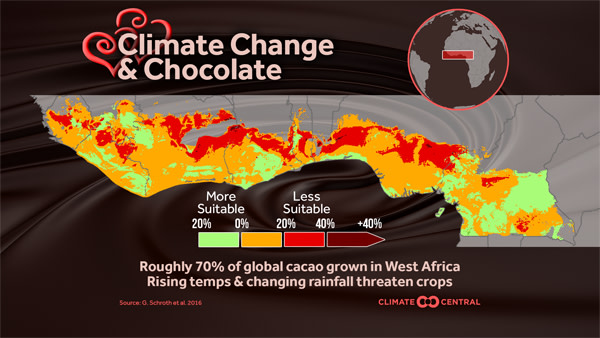Valentine’s Day is a holiday with no shortage of symbols. But two of the most ubiquitous, Champagne and chocolate, are at risk from rising temperatures and changing rainfall patterns due to climate change.
Varieties of sparkling wine are grown around the world (including in the U.S.), but these wines cannot be called Champagne unless they are made from grapes grown in the Champagne region of France. For now, a rise in temperatures seems to have produced higher quality wines, but if the world continues warming at the current pace (RCP8.5 emissions scenario), the consequent 2°C/3.6°F rise in temperatures by mid-century would push the Champagne region out of its peak production climate. This would spoil grape harvest yields and negatively impact the quality and production of wine, forcing vineyards to move north to new suitable climate zones. So the world will still have bubbly in the future, but Champagne itself could be a thing of the past.
Similarly, the climatic suitability of regions where the cacao tree grows is changing. Cacao trees, whose beans are the raw material for chocolate, currently grow within an area spanning about 20 degrees north and south of the equator. In these areas, temperatures are expected to rise about 2.1°C/3.8°F by 2050 if greenhouse gas emissions continue on their current trend. While cacao trees can endure high temperatures, this is likely beyond their adaptability threshold.
In West Africa — which supports about 70% of the world’s cacao trees — rising temperatures aren’t projected to be accompanied by an increase in rainfall, making drought more likely in an area already susceptible to dry conditions. In addition, higher temperatures will increase evapotranspiration, which could cause significant damage to cacao trees. Climate change is projected to cause areas of West Africa to lose up to 40% of their suitability (based on 24 climate variables) for cacao trees by 2050, wreaking havoc on global chocolate supplies. Research suggests other cacao growing regions of the world, such as the Americas and Asia, could see similar changes to climatic suitability.
Which brings us back to the U.S., which is the second largest global market for Champagne and the largest importer of chocolate products in the world economically. The nation is also home to Mars, Inc., the largest chocolate manufacturer in the world. In the week leading up to Valentine’s Day, chocolate sales reach their third highest peak for the year, after Halloween and Easter, and about 1.6 million bottles of Champagne will be sold.
This week's graphics and information came primarily from PNAS and ScienceDirect.
